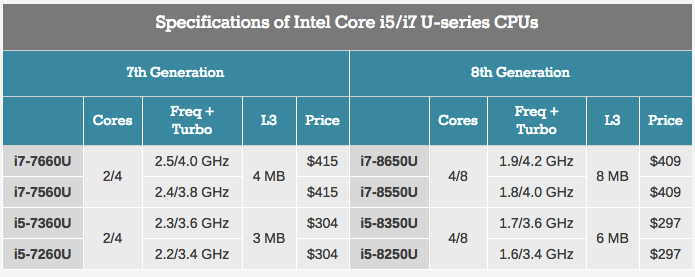This new release comes in the form of four 15W U-series mobile processors with max clock speed of 4.2GHz. Compared to the 7th generation’s two cores and four threads, new chips have four cores and eight threads. Intel has also claimed that the new Kaby Lake refresh chips will deliver 40 percent performance boost over their 7th generation counterparts.
8th Gen Kaby Lake Refresh vs. 7th Gen Kaby Lake: Specs

These initial U-series CPUs are built for laptops and ultrabooks; the new 8th generation desktop processors will be released later this year.
Find more details in this announcement article by Intel.
Intel’s 8th Gen Core label is confusing as hell
While this release marks the jump from 7th to 8th generation of processors, some readers might get confused to find them based on the same Kaby Lake architecture, which was itself a minor update of Skylake, for CPU and GPU. With some improvements, Intel is called this release “Kaby Lake refresh.”
Intel’s decision for generational increment has been either inspired by new chip architectures or an improved version of previous version’s architecture. With this release, Intel is combining both by offering 14+ (Kaby Lake refresh), 14++ (Coffee Lake), and Cannonlake (10nm) under the same generation. So, the 8th generation label doesn’t mean anything specific.
This might confuse an average person. While all Kaby Lake, Coffee Lake, and Cannonlake will wear the same “8th Gen Intel Core” badges, they’ll have different levels of jumps in performance.
Intel has said that the first laptops powered by 8th Gen Intel Core processors will be available via OEM partners in September.

Comments
Post a Comment